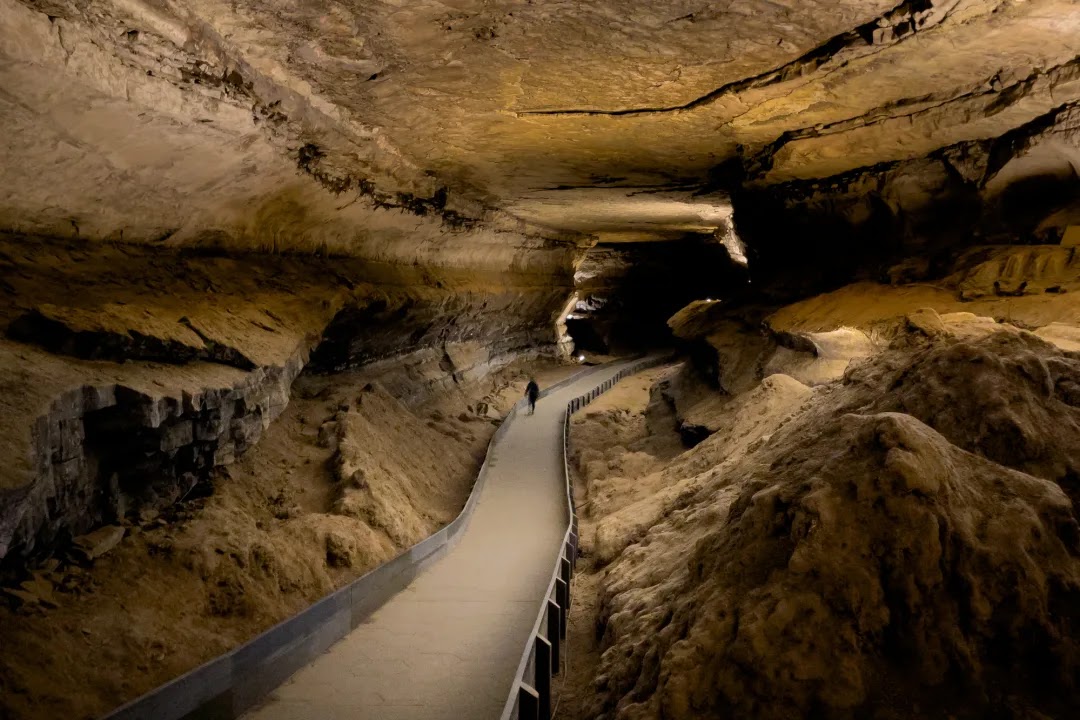While humans have been drawn to caves for millennia—as shelters, burial places, and mythical portals to the underworld—the golden age of cave exploration dawned only in the past several decades: Many of the world’s most impressive caves have only been discovered since the 1960s.
Whether you’re a spelunker (an amateur caver knocking about) or a professional speleologist documenting caves unknown to science, here are eight of the world’s biggest caves to add to your bucket list.
1. Son Doong Cave // Vietnam
Discovered by timber harvester Ho Khanh in the early 1990s but unexplored until 2009 [PDF], Son Doong Cave in the remote jungles of Vietnam holds the title of the largest cave in the world by volume. Son Doong is a sprawling network of tunnels and caverns, the largest of which could contain an entire New York City block complete with 40-story buildings, according to a 2015 National Geographic expedition. Sections of the cave’s ceiling have collapsed, creating colossal skylights called “dolines” that allow life to flourish hundreds of feet beneath the forest floor. If you can’t make it to Vietnam, explore Son Doong on this spectacular 360-degree virtual tour.
2. Mammoth Cave // Kentucky, United States
Mammoth Cave in Kentucky is the longest cave system in the world as of 2023, with 426 miles explored—and scientists estimate another 600 miles have yet to be discovered based on measurements of air movement within the caves. Mammoth Cave has drawn visitors since the 1800s, and 10 miles of underground passages are accessible to tourists today. Frequent musical events and an annual “cave sing” concert highlight the cave’s remarkable acoustic properties.
3. Veryovkina Cave // Abkhazia, Georgia
Veryovkina is the deepest cave in the world, stretching 1.4 miles beneath the surface. It takes professional speleologists about a week to descend all the way and return, braving waterfalls, tight squeezes, and sheer drops. But the payoff is idyllic—Veryovkina cave’s terminus is a “beautiful turquoise lake” about 50 feet long and 25 feet wide “surrounded by jet-black limestone,” cave photographer Robbie Shone told National Geographic.
4. Sac Actun // Mexico
The longest underwater cave system in the world, Sac Actun winds more than 235 miles under Mexico’s Yucatán peninsula. The adventurous can take a dip in the Sac Actun system via more than 228 cenotes—naturally occurring swimming pools that form when sinkholes connect the surface to the underwater caves.
5. Derinkuyu // Türkiye
Rediscovered in 1963 after a private citizen’s home renovation, Derinkuyu is believed to be the largest hand-carved cave system in the world. The massive subterranean city was excavated in the region’s soft volcanic ash rock during the 1st millennia BCE, when a revolving door of invaders made an underground retreat an asset. Researchers estimate Derinkuyu could house up to 20,000 people along with livestock and food stores. The complex was built to withstand sieges—it’s equipped with elaborate ventilation shafts and deep wells in addition to creature comforts like chapels and wine presses.
6. Jewel Cave // South Dakota, United States
Over 215 miles of the Jewel Cave system have been mapped to date, according to the National Park Service—99 percent of which has been explored since 1959. It’s a “breathing cave,” meaning the cave releases or sucks in air as the surface pressure changes with the weather. The cave takes its name from faceted crystals called calcite spars that stud the walls. Jewel Cave is also the only place in the world where the public can view hydromagnesite balloons, a rock formation that looks like the deflated aftermath of a stone party.
7. Ox Bel Ha // Mexico
A near neighbor to Sac Actun in Mexico’s Yucatán peninsula, Ox Bel Ha spans just over 197 miles of underwater passages—but you didn’t always need a bathing suit to visit. During the most recent ice age, between 25,000 and 18,000 years ago, sea levels were more than a hundred feet lower near Mexico and the caves were dry and accessible to humans. Archaeologists have found soot from ancient fires in Ox Bel Ha and three purposeful burials of human remains, suggesting a ritual significance to the site. Speleologists believe Ox Bel Ha and Sac Actun are likely connected—finding a link between the two would rocket the combined system to the status of largest cave in the world.
8. Lechuguilla Cave // New Mexico, United States
Lechuguilla Cave started its career as “Misery Hole,” a 90-foot pit in southeast New Mexico where miners extracted bat guano for use in fertilizers and explosives. It wasn’t until 1984 that cavers received approval from the National Park Service to pursue the source of a mysterious breeze emanating from the cave floor. In 2023, Lechuguilla is considered the world’s eighth longest cave with more than 150 miles explored. Lechuguilla is home to a variety of speleothems—fancifully shaped mineral deposits—like cave pearls, U-loops, and the iconic Chandelier Ballroom, with the world’s largest known gypsum stalactites.













